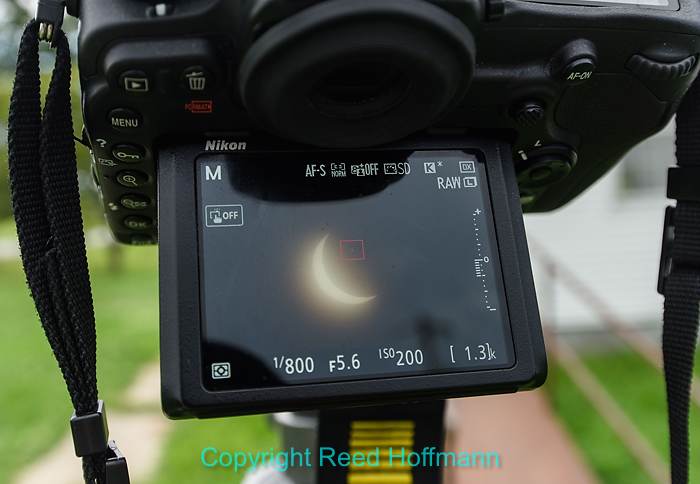Best laid plans and all that…
I’d been preparing for the solar eclipse for the last couple of months. Solar filter? Check. Exposure tests? Check. Exposure Delay mode, Intervalometer, multiple tripods, releases, spare batteries, power inverter for the car, food, water, rain gear, tape, etc. etc. etc. Check, check and check.
Sunday afternoon I drove up to Richmond, Missouri to scout locations. Found a nice farm with a great view to the south and west. It even had an old barn I could use in a wide shot. Everything looked good until I saw the weather forecasts that night. Clouds, possible storms. I’m a positive person, though, so I figured, “no worries, it’ll be okay.”
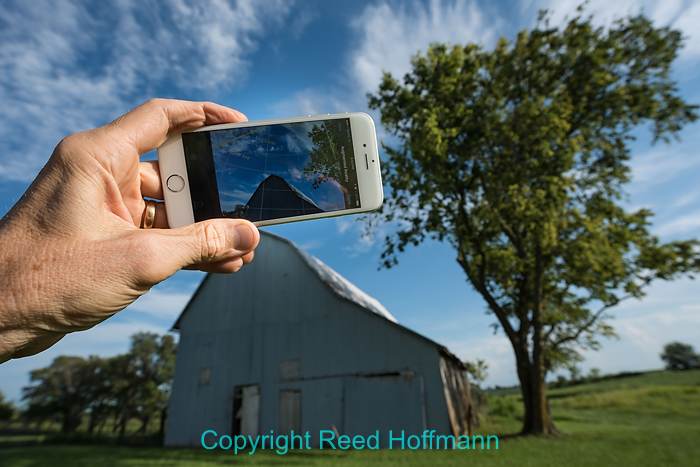
This was the beautiful location I’d planned to use. The app on my phone showed where I’d need to be to have the eclipse happening above the barn. Photo copyright Reed Hoffmann.
Long story short, it wasn’t okay. Storms rolled in and the radar map showed no hope for a break in the sky. But an hour southeast looked promising. So I joined a steady stream of cars headed to Marshall, Missouri. By the time I got there, and found I needed to go even further south, time was running out. I finally pulled into the lot of a small church, hoping the steeple might make a nice foreground for a wide shot.
Totality was now just twenty-minutes away and the sun was starting to burn through. Time to get to work. And also time to ditch my original plans.
One of the most important things I learned as a newspaper photographer was how to make a picture when things went wrong, making the best of a bad situation. My original plan assumed clear skies and two hours to set up. That involved four still cameras (three on tripods, one hand-held) and one camera capturing video. Now, with time running out, I needed to simplify. I’d use just three cameras. One with a long lens to shoot tight shots of the eclipse, one hand-held to shoot a few wide shots during totality, and one more on a tripod to capture video – just turn it on and let it run.
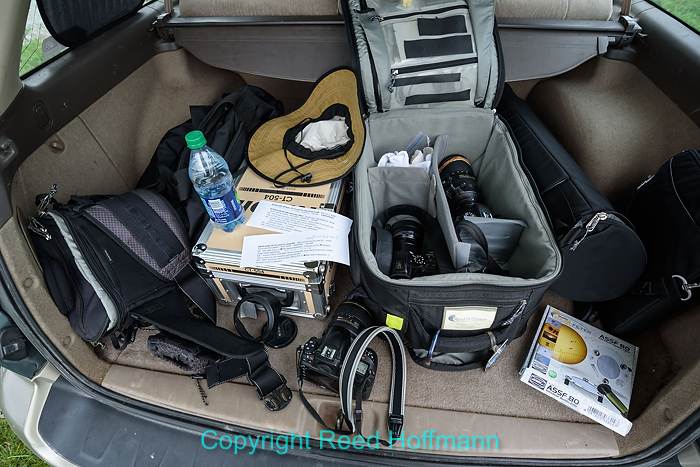
This was just some of the gear I took to shoot the eclipse. By the time I got to a place where I could actually make pictures, most of it remained in the car. Photo copyright Reed Hoffmann.
The priority was the tight shots, so I mounted my Nikon 500mm f/4 lens with 1.4X teleconverter to my D500. That would give me 700mm on a DX (crop-sensor) body, for an equivalent of 1050mm (on a full-frame body). I already had a ten-stop neutral density filter in the lens, which would allow me to shoot the sun as long as I used the LCD (using the viewfinder could damage my eye). I mounted that rig on a large tripod, hung a water weight under the tripod to help stabilize it and tilted the gimbal mount so I could aim the camera nearly vertical. Because of the layer of clouds, I couldn’t use the exposure from my tests, so quickly shot a couple of frames to determine proper exposure.
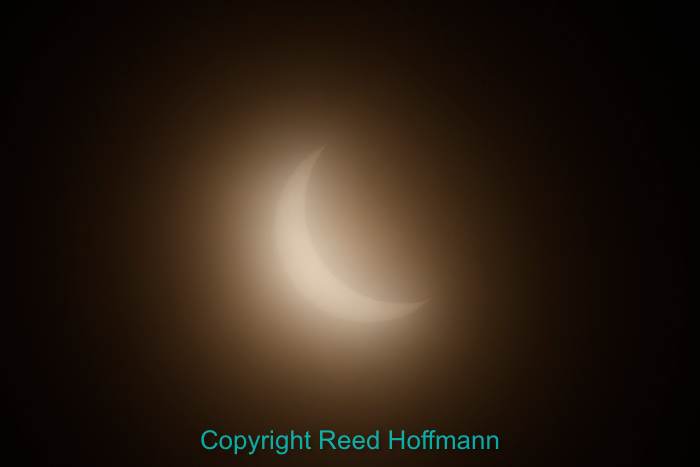
Even shooting through the clouds, I needed a ten-stop neutral density filter to drop the brightness down to a reasonable amount. With that filter, my settings here were ISO 400 1/500 at f/5.6. After totality, when the clouds were gone, this same amount of crescent required an exposure of ISO 100, 1/8000 and f/22 with the same 10-stop ND. Photo copyright Reed Hoffmann.
Then I grabbed my second camera, the Nikon D810 with Nikkor 18-35mm lens. I set it for 1000 ISO, f/5 and -1.0 EV in Aperture Priority. I expected that to be a good starting point when the sky got dark during totality.
Finally, I set up the last camera on a smaller tripod, with a wide-angle lens, to start recording video. I didn’t expect much from it because I was right next to a highway, with lots of road noise. Bad audio can kill good video.
Doing all of that took about ten minutes, and meant I could now concentrate on one thing – shooting the eclipse with the D500 and long lens. It also meant I wouldn’t be using the solar filter I’d bought, which was on the 80-400mm lens. The pictures I most wanted were the close shots of the sun entering and during totality. I needed the faster 500mm lens for that, and knew I no longer had the luxury of time to set up and prep both cameras. Using just one camera also made it easier for me to change exposure. When I began shooting, thin clouds were reducing the sun’s intensity, so I was at lower settings than planned. As it neared totality and the clouds drifted out, the brightness increased and I had to raise my shutter speed and reduce the aperture. And then reaching totality, I had to pull the ND filter and drop the shutter speed much lower. Working with only one camera made that possible. I’d have never been able to get both cameras up and running, and do a good job with both of them, in the short time available.
In the middle of totality I grabbed the D810 with wide lens to shoot a few frames. The sky had gone dark, and a small window with a cross in the steeple lit up. Then it was back to the long lens for the end of totality and the rest of the eclipse.
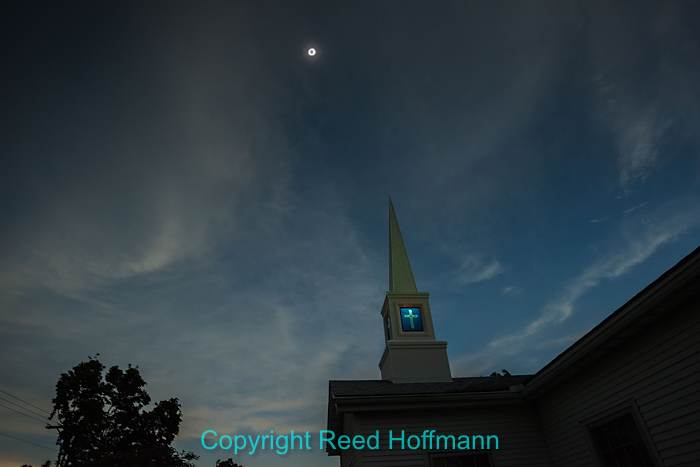
This was the one wide shot I made during totality, hand-held. If I’d had more time, the camera would have been on a tripod. Nikon D810, ISO 1000, 1/30 at f/5, -1.0 EV, Nikkor 18-35mm lens at 20mm. Photo copyright Reed Hoffmann.
Did I make mistakes? Yes. I pulled the ND filter from the 500mm lens too early, and while switching back missed the diamond ring. I also dropped my shutter speed too low at one point during totality and ruined some of the HDR shots I was trying to get (because of blur). Despite that, I still managed to get a number of good photos. And the wide shot worked out better than I had any reason to expect. I was disappointed in not being able to create a time-lapse of the eclipse moving across the sky, and the video wasn’t what I’d hoped. But I’m not complaining. I was lucky to be able to get to a spot where I could witness totality, and that was worth all the trouble. Even if I hadn’t been able to make pictures, it was truly a unique experience.
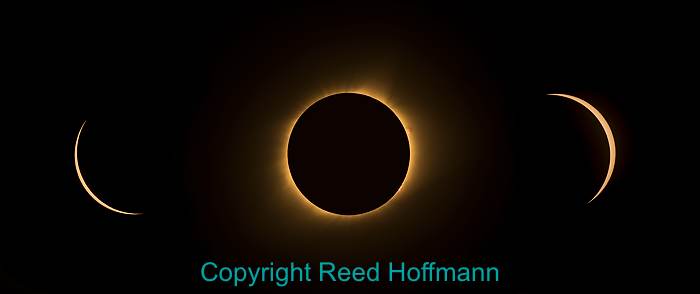
Three photos were combined in Photoshop to create this composite. The crescent exposures are listed above. The center image, during totality, was shot at ISO 100, 1/50 second at f/5.6. Photo copyright Reed Hoffmann.
What now? I’ve got good frames of the corona where I was bracketing exposure, and I plan to create an HDR image from them. I’m going to make a print of the three-image composite. And most importantly, I’m going to write down what worked and didn’t. After all, the next solar eclipse is on April 8, 2024, only seven years away. That will give me a chance to do this all over again, and do a better job of it. Can’t wait!
(If you like this story, please share it with your friends, and let them know about the links about photography I post on my business Facebook page. I’m also on Instagram and Twitter, @reedhoffmann)

With only a few minutes to set up my gear and check settings, I opted for one camera and lens. Here’s my Nikon D500 with 500mm f/4 lens and 1.4X teleconverter on a gimbal mount. Note the cable release. Originally I’d hope to use the intervalometer to bracket my shots, but had to change plans in the last-minute rush. Photo copyright Reed Hoffmann.

